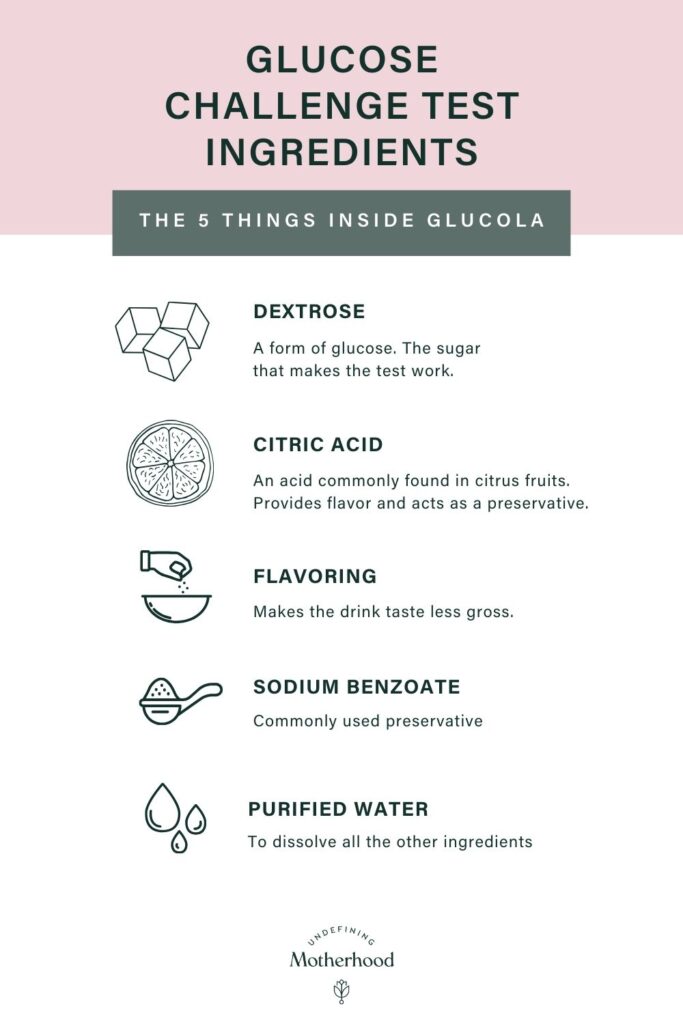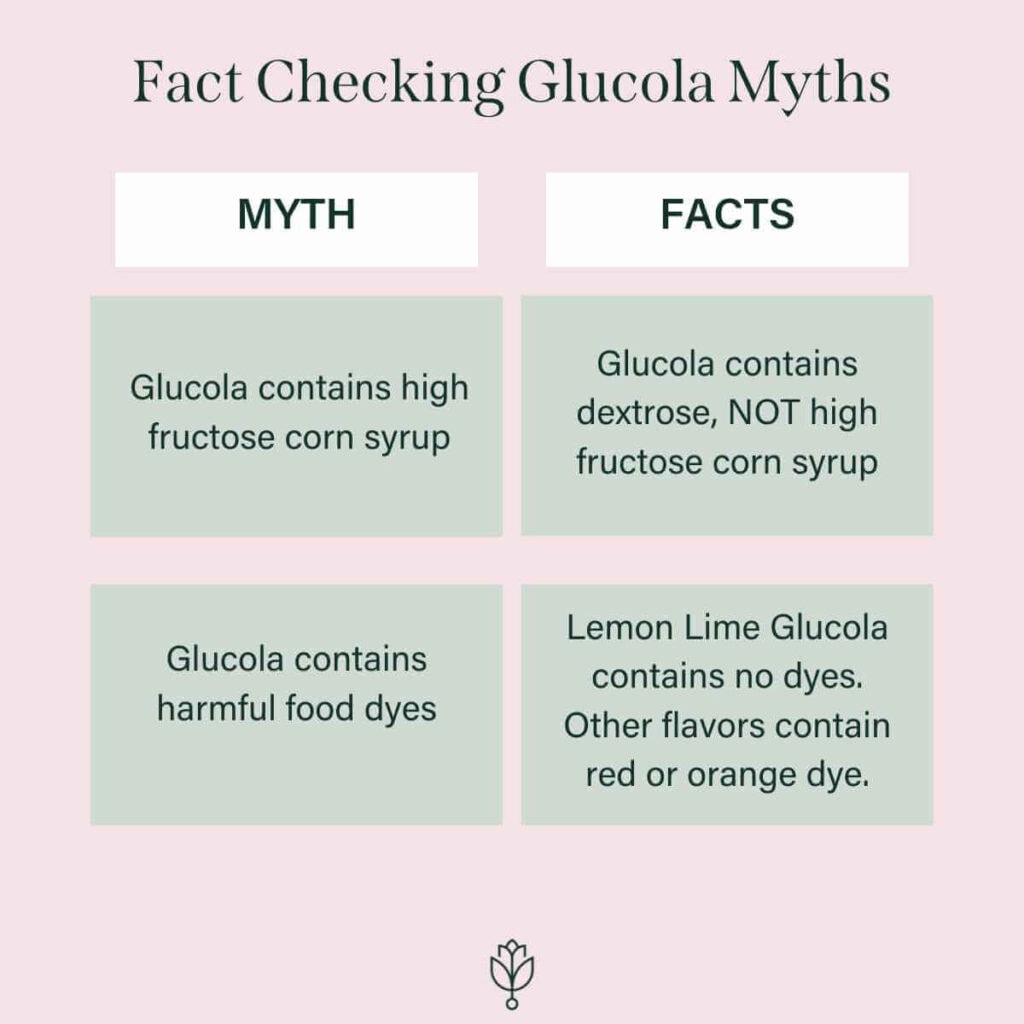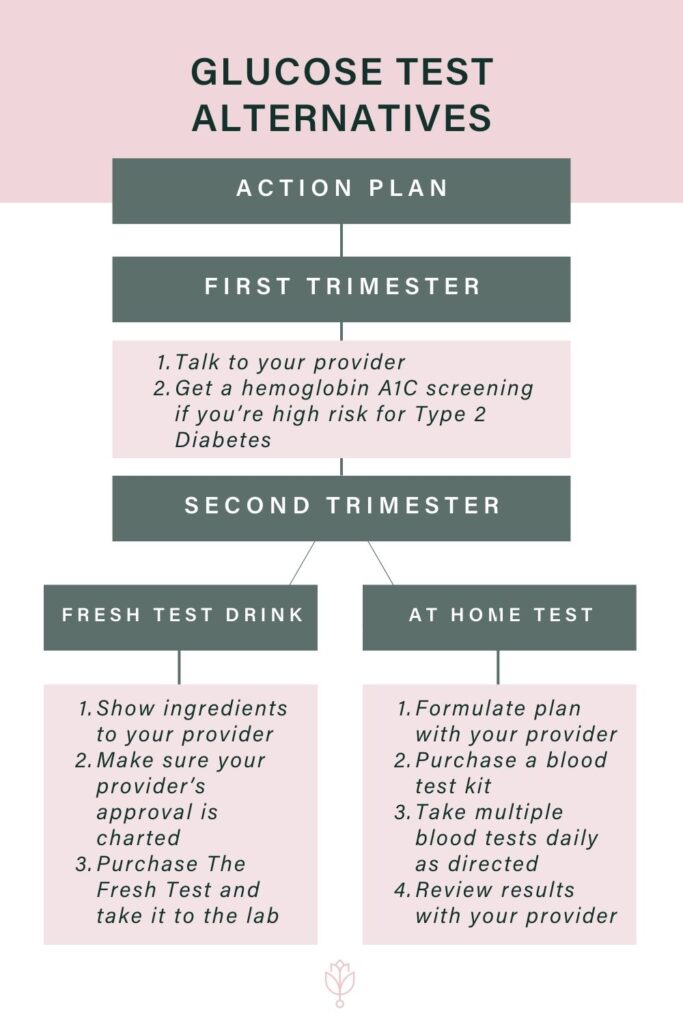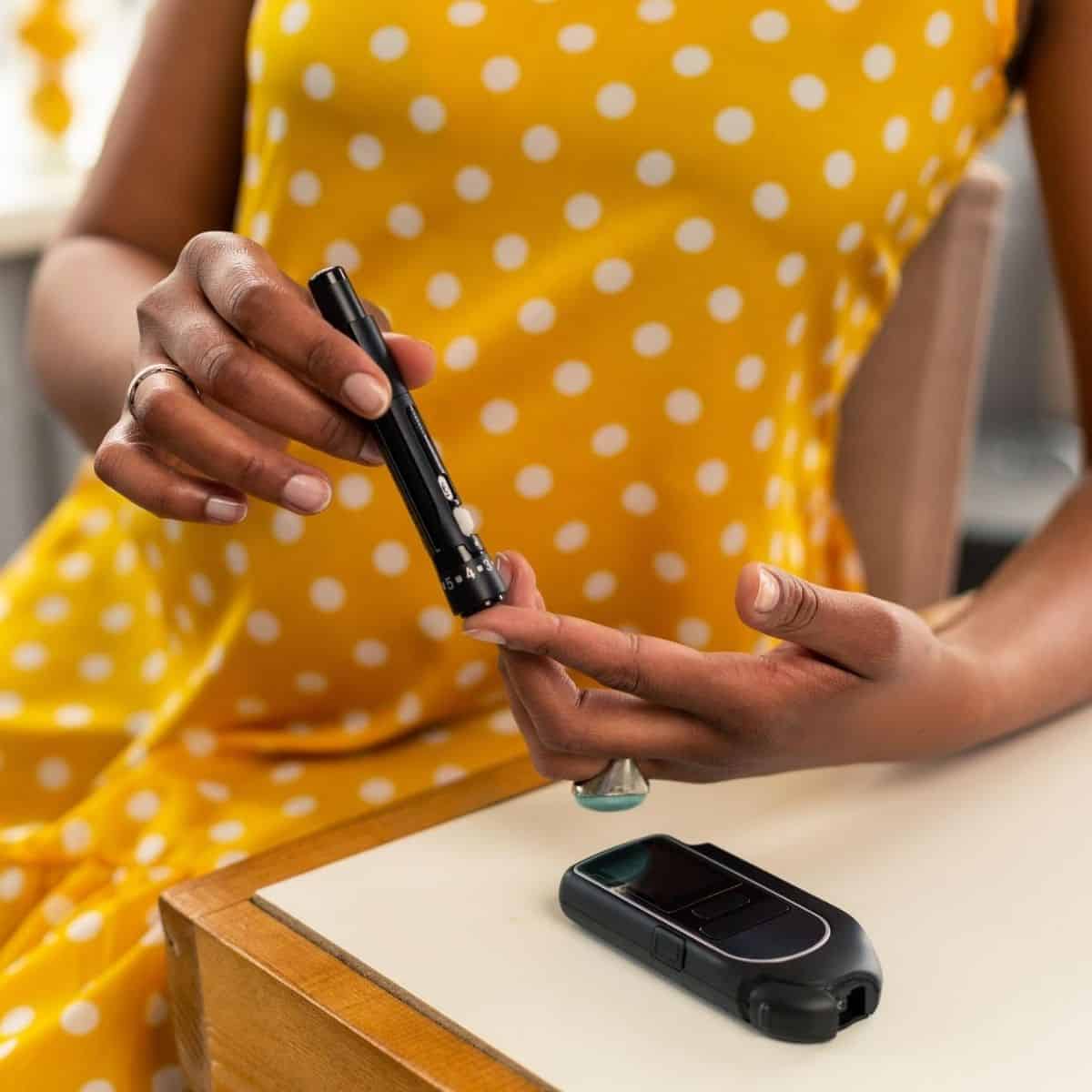Can you refuse the glucose test when pregnant? Sure. But do we recommend it? Definitely not.
If your concerns relate to Glucola–the standard glucose test drink–there are some alternatives, and we’ll walk you through the pros and cons of them. But many of the glucose test alternatives touted by wellness influencers–like 100% fruit juice and jelly beans–have been proven ineffective. Don’t worry, we’ll explain why!
There’s increasing evidence that it’s ideal to stick with the traditional drink for the glucose challenge test when possible. Glucola is the only method of glucose testing approved by both the American Diabetes Association (ADA) and American Congress of Obstetricians and Gynecologists (ACOG). Of course, some people need a glucose test alternative–perhaps for reasons like allergies, a history of bariatric surgery, or dumping syndrome.
We’ve pulled in our resident scientist to do all the digging, and we’re excited to share the most up-to-date information on Glucola, as well as the safest Glucola alternatives if you need a different way to take the glucose challenge test.

This site contains affiliate links, meaning that we earn a small commission for purchases made through our site. We only recommend products we personally use, love, or have thoroughly vetted.
Why Trust Us?
Samantha Radford, PhD is an expert in Chemistry and Public Health and our Resident Health Scientist. Her Exposure Science training from Emory University makes her the ideal person to assess the risks associated with different chemicals exposures through food, drink, and beyond. Fact-checked by Katy Huie Harrison, PhD; Edited by Sarah Creel, PhD.
Disclosure: This article contains affiliate links. As an Amazon Associate I earn from qualifying purchases. You can read my full policy here.
Purpose of Glucose Test During Pregnancy
According to the Center for Disease Control and Prevention (CDC), 2-10% of pregnancies each year develop gestational diabetes.
Gestational diabetes is a condition that can develop during pregnancy in which a person’s body doesn’t make enough insulin, a problem that can cause blood sugar to spike.
Because gestational diabetes (GD) is often a symptomless disease, it’s important for OBGYNs and midwives to screen for the condition, usually sometime between weeks 24 and 28 of pregnancy. Once gestational diabetes is diagnosed, it can be monitored and treated appropriately.
The potential negative outcomes of gestational diabetes, according to the CDC, include:
- Gestational hypertension (high blood pressure during pregnancy)
- Increased risk of C-section (due to higher risk of a large baby)
- Mom developing type 2 diabetes later in life
- Baby developing type 2 diabetes later in life
Clearly, screening for GD is important, but if you’re worried about the traditional glucose test, there are other ways.
What’s in Glucola?
Most concerns about the glucose tolerance test stem from the ingredients in Glucola.

Let’s break this down even further.
- Dextrose is simply a form of glucose. It is a naturally occurring sugar found in corn, fruits, and honey. This glucose likely comes from corn.
- Citric acid is an acid commonly found in citrus fruits. It is a natural preservative and improves taste.
- Artificial flavoring is used because, well . . . that way your Glucola tastes like something other than just sugar water.
- Sodium benzoate is a common preservative used in acidic foods (and is the ingredient that is most likely to concern expecting mamas). Some studies have connected sodium benzoate with increased risks of oxidative stress, inflammation, ADHD, and allergies. Under certain conditions, it can convert to benzene, a carcinogen. However, the FDA has reported that the low levels found in beverages are safe.
Misinformation About Glucola
Before we talk about alternative options, let’s address some misconceptions about Glucola. It’s is the most rigorously tested option available to screen for gestational diabetes, which is a screening the American College Of Gynecology confirms all pregnant people should receive.
As such, while we understand needing alternative options, you deserve to understand the facts about what’s been proven and validated in large-scale clinical trials before making a final decision. So let’s take a look at the facts and do a bit of myth busting, shall we?

If you plan to drink Glucola but want to be sure you don’t ingest red or orange dyes, check with your doctor or lab in advance to be sure the lemon lime flavor is an option.
Some people do report feeling sick after the Glucola drink, and that actually makes sense –it’s likely connected with the insulin spike and drop that comes from ingesting any large amount of sugar. Realistically, you’ll likely experience the same side effects after any good alternative (just like when I was engaged, I had a tummy ache after trying too many wedding cake and frosting samples!).
Pro Tip: To mitigate the sugar hangover, we recommend taking a protein shake or bar with you to the test so you can start balancing your glucose as soon as they finish that final blood draw!
Best Glucose Test Alternative: The Fresh Test
Our favorite Glucola alternative is the The Fresh Test. It functions very similarly to Glucola, but it doesn’t have any artificial flavors, colors, or preservatives. Both The Fresh Test and Glucola are sweetened with dextrose (a form of glucose) and will lead to the same physiological response.
It’s important the drink you use contains dextrose, not another type of sugar. Candy is usually made with fructose and sucrose (table sugar). Fruits contain a mix of fructose and glucose (and sometimes other sugars). These other sugars aren’t broken down the same way in the body, which is just one reason it doesn’t work to sub in the same amounts of sugar from any random sugar source, like 100% fruit juice or candy.


This is why we consider The Fresh Test the best alternative–with your doctor’s approval–for moms who are concerned about the ingredients in glucola and are able to handle the glucose load.
The only caveat: make sure you use the exact amount of water The Fresh Test recommends, and make sure you thoroughly mix the powder into the water so it completely dissolves. This ensures you get the correct dose of glucose for your test.
What Makes Fresh Test Stand Out?
What makes The Fresh Test stand out is that it’s made with simple ingredients like organic lemon and peppermint. It doesn’t have any of the artificial stuff you might worry about.
It’s a choice that lets you feel good about what you’re putting into your body, especially at a time when you’re already thinking so much about your baby’s health.
If you want to talk to your doctor about glucose test alternatives, this is where we suggest you start.
While we can’t guarantee your doctor will be open to you taking The Fresh Test, it is recently FDA Approved and has been shown in a very small internal study to be comparable to the traditional glucose test. That said, there are major limitations to this study, most notably that it only contained 10 test subjects, none of whom were pregnant.
With that said, it’s such a simple solution that the small sample size isn’t really cause for concern because of the similarity between dextrose and glucose.
How to Do an At-Home Glucose Test, If Needed
If you really can’t handle the glucose spike, like if you’ve had bariatric surgery or have experienced dumping syndrome, you’ll need to work with your OB to create a plan for at-home testing. This isn’t a fool-proof method and will occasionally miss cases of gestational diabetes, but it is the next best option for moms who need it.
A study of how to screen and manage gestational diabetes after bariatric surgery recommends testing for regular type 2 diabetes in the first trimester using an A1c test (NOTE: A1c testing is not recommended for gestational diabetes screening). Professionals then recommend performing at-home finger prick blood sugar tests daily before and after meals for 3-7 days, somewhere between 24-28 weeks of pregnancy. You’ll have to record the results of these tests to present to your doctor for analysis.
While the finger-prick at home test isn’t ideal, it’s the best alternative we have for these special cases who can’t tolerate the Glucose Challenge Test.
Drawbacks to At-Home Testing
Before you run and chat with your doctor about this option, we do want you to understand that there are some drawbacks to at-home testing:
- You have to perform blood glucose testing on your own multiple times a day for multiple days. This requires you to prick your finger with a lancing device, which will produce a droplet of blood that you can put on a testing strip that is inserted into a blood glucose meter. So, if repeated finger pricking isn’t going to work for you, then this alternative likely isn’t a fit.
- You may have to purchase her own blood test kit. For U.S. mamas, it’s possible that your insurance will cover it, but that’s not guaranteed. The traditional glucose test is generally covered by insurance as part of your standard prenatal care. (The good news is that a glucose monitor is relatively inexpensive. I own this one and have used it for years to check my blood sugar levels when they feel low.)
- It requires consistency. If you forget one test, your healthcare provider may ask you to recreate the test all over again. Not fun.
- Not all providers like the idea of the at-home glucose test because it does miss some cases of GD. Talk to your doctor to make sure that they are comfortable with this approach.
How to Talk to Your Doctor about Alternatives
Think The Fresh Test or a glucose test alternative is a good fit for you? Chat with your care provider about it!
But as you go into the conversation, go in educated, and make it clear to your provider that you take the test seriously and want accurate results–you just want to obtain them a different way.

Here’s a deeper dive into this step-by-step action plan:
- Start discussing your plans with your care provider during the first trimester so you have time to get to know each other and trust one another’s decision.
- If you’re at risk of type 2 diabetes, request a hemoglobin A1C test during the first trimester, or ask if it’s part of your anticipated care plan.
- If you prefer to use another FDA approved glucose beverage such as The Fresh Test, talk to your provider and explain what you’re doing. Point out the ingredients so they can see that it’s the same glucose load as their usual drink (NOTE: You’ll likely need the 50g drink, but make sure they don’t use a different dose in their lab). Make sure the nurses who’ll administer your test know you plan to use The Fresh Test and that you have the doctor’s okay. Finally, make sure you buy it early enough that you can bring it with you to your test!
- If you need an alternative at-home glucose test, outline your reasoning and take that to your care provider early in the second trimester (if you’re finding this article later than that, you can still start here!). This can facilitate a conversation in which you plan exactly how your at-home test will work and will give your doctor time to plan any additional tests they’d like to conduct, such as a fasting glucose test.
And if your doctor absolutely won’t budge?
Hear them out. We always say, we’re experts in our own bodies, but our doctors are experts in their field. That said, if you feel strongly about something and your doctor isn’t willing to listen to your concerns as a patient who’s taken the time to educate herself, you may want to reconsider whether they’re the best fit for you, your pregnancy, and your labor experience.
General Glucose Test Alternatives FAQ
There are alternatives to glucola, with the best one being The Fresh Test, an alternative glucose drink with no artificial coloring, flavoring, or preservatives. If your concerns with glucola relate to food dyes, note that lemon-lime glucola does not contain dyes.
There is a method for testing using at-home finger pricks and a blood glucose monitor, but this method is typically reserved for people with a medical condition that prevents them from taking a traditional glucose challenge test–usually a history of bariatric surgery or dumping syndrome.
While you have the right to opt-out of the glucose test, knowing whether you have gestational diabetes is essential. We suggest working with your doctor to find the best version of the glucose challenge test for you.
Have you ever done an at home glucose test or tried The Fresh Test? Tell us about it in the comments!












